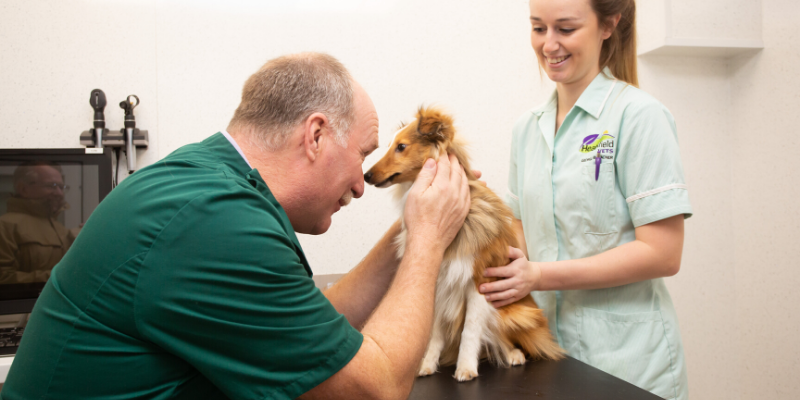
Luxating patella is another term for a dislocating kneecap. In a healthy dog’s knee, the patella (kneecap) sits in a groove (trocheal groove) in the femur and slides up and down this groove as the knee bends. A luxating patella means the kneecap slips out of this groove, prohibiting the knee from extending. The patella can either slip to the inside of the knee (medial luxation) or to the outer side (lateral luxation). Patella luxation can cause pain and lameness, owners often see a characteristic ‘skip’ of the hind leg.
As the patella slips from the groove, the cartilage can begin to wear against the thigh bone, causing pain. This process can also lead to progressive arthritis. The abnormal action of a luxating patella can also stress the cranial crucial ligament (CCL), making the dog more at risk of a cruciate ligament rupture.
Signs of a luxating patella
You may see the ‘skip’ when your dog suddenly holds their leg up and limps for a few steps until the patella glides back into place, in severe cases the patella may need to be replaced manually. In very mild cases, a luxating patella may only be noticeable under vet examination.
More subtle signs can include your dog walking stiffly as they are unable to fully extend their leg or sitting with their knee pointing outward.
Patella luxation can occur in one or both knees.
What causes a luxating patella?
It is most commonly due to a genetic predisposition. The luxation can be due to the groove the kneecap slides in being too shallow or from a skeletal defect such as hip dysplasia. Toy and small breed dogs such as Chihuahuas, toy poodles, bichons frises and Pomeranians are most susceptible, though any dog could be affected. Medial luxation is the most common type and is the most often seen in smaller breeds whilst lateral luxation is the most common type in larger breeds.
Breeding from a dog with a patella problem is never recommended.
How is a luxating patella diagnosed?
A luxating patella can be diagnosed during a physical vet examination and is graded based on the severity of dislocation.
Grade 1 – The patella stays in place normally but can be dislocated manually. Most likely only noticed during a vet examination as the patient displays no symptoms.
Grade 2 – The patella occasionally dislocates and returns by itself. Owners may notice the characteristic ‘skip’.
Grade 3 – The patella is permanently dislocated but your vet can manually replace it in the groove.
Grade 4 – The patella is permanently dislocated and cannot be replaced in the groove manually.
Your vet may also take radiographs to assess any skeletal deformity and signs of osteoarthritis.
How is a luxating patella treated?
For grade 1 and 2 cases the condition may be managed with weight management, physiotherapy and controlled exercise. Some cases may also require medicinal pain management.
For moderate grade 2 cases, grade 3 and grade 4 cases, surgical treatment is recommended.
What does patellar luxation surgery involve?
The purpose of surgery is to ensure the patella can no longer be dislocated by realigning the quadriceps muscle to a more normal alignment, relative to the entire limb. To do that, several steps are taken.
- The trocheal groove is deepened so the patella sits further back in a normal position.
- The tibial crest (the bone the tendon in the patella attaches to) is cut and moved to a more lateral position in order to straighten the patella mechanism. The bone is pinned in place and will heal over the next 4-8 weeks. Wires may be attached to the pins to increase stability.
- The soft tissues on either side of the patella will either be too loose or too tight. The tissues can be cut to release tension or tightened if too loose.
- If bowing of the femur is present, this may need to be corrected with plates and screws.
How long does recovery take and what should I expect?
As with any surgery under general anaesthetic, your dog may feel a little dozy and become vocal for the first 24 hours at home. They will need to have their wound protected from licking or nibbling with a collar. You will need to return to see your vet a few days after surgery to have the wound checked over. Your dog will also come home with pain medication to use whilst recovering. It’s important to remember that whilst patella luxation surgery is very common, it is a complex procedure and your dog will need time to heal.
For recovery from this type of surgery you will need to rest your dog in a crate, if you don’t have one at home there are services where one can be loaned. You can also pick up inexpensive secondhand crates quite easily. Recovery from surgery can take 6-8 weeks, your dog will need to rest in their crate and initially be taken for only short, slow lead walks. Your vet will guide you as to when you can increase exercise levels and may wish to see your dog back periodically to check on their recovery progress. Radiographs may be required 6-8 weeks post operatively to evaluate if the bones have healed correctly if repositioning of the tibial crest or correction of bowing of the femur was required.
The prognosis for dogs after a patella luxation repair surgery is very good, your vet will guide you as to how to return your dog to normal exercise and activity.
Is patellar luxation surgery performed at Heathfield Vets?
In the majority of cases our vet Philip Snyman is able to perform surgery to correct a luxating patella. In some complex cases a referral to a specialist may be required.
Can I prevent patellar luxation?
Whilst it may not be possible to prevent patellar luxation as it is usually genetic in origin, keeping your dog healthy and attending routine health checks with your vet means signs of disease can be spotted early. Maintaining a healthy weight and level of exercise will also help with their mobility overall.
The most important thing is to never breed a dog with signs of patella luxation in order to stop the condition being passed to their offspring. If you are thinking of breeding, having your pet vet checked for any genetic diseases, such as a luxating patella, is really important before you commit. Speak to your vet about pre-emptive diagnostic tests (such as radiographs) to check for hip or elbow dysplasia or other genetic skeletal defects which could potentially cause a luxating patella.
When buying a puppy, as always, do your research. Check that both parents are under the care of a vet and ask if there have been any problems with the parents that could potentially impact their offspring, such as a luxating patella. A good breeder will be open and honest about their own dog’s health and will have routine health checks and diagnostic testing performed.
Call us on 01435 864422 if you think your dog may be showing signs of patella luxation.
Heathfield Vets – Quality Care With A Friendly Face

